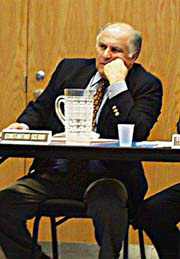A preliminary report of new federally mandated fourth grade tests has resulted in the Huber Street elementary school, an institution rated as one of the best in the state last year, receiving a warning letter this year.
This appears to have been due not to test scores but to the way the state tabulated the number of students actually taking the test, said local school officials.
The state released its preliminary results from the fourth grade NJASK (New Jersey Assessment of Skills and Knowledge) fourth grade test, showing that Huber Street was among 275 elementary schools statewide that allegedly failed to meet the requirements as set forth under the federal and state guidelines. Last Year, Huber Street was named as one of the top 10 in the state.
The NJASK-4 test replaces the old Elementary School Proficiency Assessment exam and is significant in that, in keeping with the federal No Child Left Behind Act, it emphasizes how various “subgroups,” such as blacks, Hispanics, special education, and limited-English students, performed on the test.
This is the first year the new test has been administered, and Schools Superintendent Constantino Scerbo said there have been constant adjustments that the district could not anticipate.
“We knew there would be a participation element, but we didn’t realize it would be as important as it is,” he said.
While students at Huber Street greatly exceeded state averages in both the mathematics and language skills portions of tests, the state penalized Huber Street on a technicality, claiming that Huber Street failed to test the required 95 percent of its students. According to the state, Huber Street only tested 92.8 percent.
Scerbo said the state was dead wrong, and made his complaint known to state officials.
By requiring the schools to test a vast majority of students, the state and federal governments make certain that schools do not test only their best students, artificially inflating the results.
Huber Street has 75 students who should have taken the test. In language arts, the state recognized 72 of the 75 as having taken the test, or about 96 percent. In mathematics, however, the state acknowledged only 71 students, so that percentage in that category dropped under the state requirement, causing the school to receive a warning letter from the state.
Three of the uncounted students, however, were special education students and they were tested under a provision accepted as an alternate proficiency test, officials said.
“These three should have been counted,” said Huber Street Principal Pat Cocucci.
State officials said a second report combining both special needs and mainstream students will reflect a more accurate portrayal, and Scerbo said he hopes this means Huber Street will be dropped from the schools currently on the warning list.
Test results
The Huber Street students who did take the test tested above the state average. According to the original report, 87.9 percent of Huber Street fourth grade students were considered proficient in language arts as opposed to the state requirement of 68 percent, and 81.7 of Huber Street School students achieved proficiency in mathematics, exceeding state requirements of 53 percent.
Under the No Child Left Behind law, if any subgroup in a school fails to make “adequate yearly progress” toward meeting the state standards for two consecutive years, that school can be classified as a “school in need of improvement,” a designation that carries with it various sanctions including a change in school leadership and allowing parents to transfer the children to other schools in the district.
Arlene Brosky, head of the Secaucus School District’s Child Study Team, called the testing concept “flawed” since groups of students vary from year to year and the fourth grade test does not test the same students each year, but a new group.
“There is no way to show yearly progress this way,” she said.
Scerbo has been concerned about the new test since it was first proposed two years ago, partly because of conflicts between federal expectations and those of the state. He noted, for instance, that the state had required elementary schools to begin teaching a second language.
“We selected Spanish as our second language, we hired a Spanish instructor and expended resources so that we could teach our students in anticipation of a state test,” he said. “To date, none of our students have been tested in Spanish. We can’t drop the problem, because tomorrow the state might tell us they’ll start up testing in the second language.”
Scerbo said school districts are forced to expend limited resources to meet changing mandates, and he called the inconsistency unfair.
